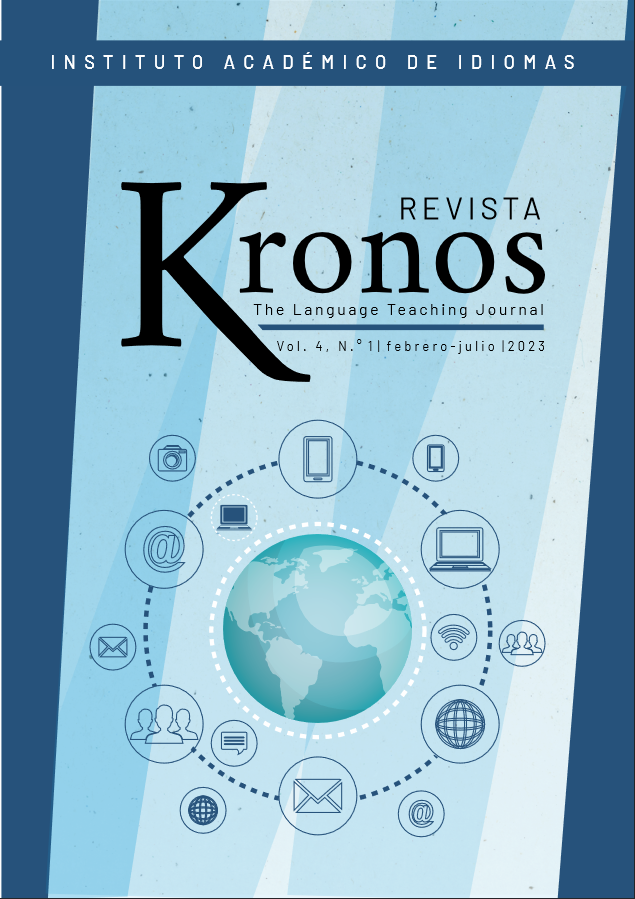Percepciones de la estrategia de enseñanza entre pares en la carrera de Inglés en una universidad pública del Ecuador
DOI:
https://doi.org/10.29166/kronos.v4i1.4310Palabras clave:
Enseñanza entre pares, desarrollo del inglés, estrategia de enseñanza, trabajo colaborativoResumen
El objetivo de este artículo es identificar las diferentes percepciones de docentes, docentes pares y aprendices pares acerca de la estrategia enseñanza entre pares; que, en detalle, consiste en el proceso en el que los estudiantes aprenden unos de otros. Algunos beneficios de esta estrategia de enseñanza incluyen el desarrollo de las habilidades de trabajo colaborativo y comunicación de los estudiantes, fomentando la confianza de los estudiantes y su capacidad de tomar el control de su propio aprendizaje. Los alumnos se sienten más cómodos trabajando con sus compañeros, lo que permite interactuar, reflexionar y explorar ideas profundamente que en un entorno dirigido por un maestro-tutor. Esta investigación se desarrolló bajo los principios de la investigación cualitativa, ya que se centró en la recolección de las percepciones sobre la enseñanza entre pares desde el punto de vista de participantes de la carrera de inglés en una universidad pública del Ecuador, a través de la aplicación de entrevistas semiestructuradas, a los mismos, quienes cumplieron los roles del docente de inglés, pares docentes y aprendices pares, a lo largo de la aplicación de la estrategia. El análisis de los datos recolectados fue temático, se concluyó que tanto el tutor como los estudiantes desarrollaron un espíritu de equipo y relaciones más empáticas; mayor bienestar psicológico, competencia social, habilidades de comunicativas y se desarrolló su autoestima; se promovió mayor rendimiento y mayor productividad en términos de mejores resultados de aprendizaje y desarrollo del inglés. En general, la enseñanza entre compañeros tuvo un impacto positivo en los estudiantes, así como una mayor participación y habilidades de los compañeros docentes y los alumnos.
Descargas
Citas
Adil, H., & Ali, A. (2018). Implementing Peer Teaching to Enhance English Students’ Language Learning: Kurdish efl Teachers’ and Students’ Perspectives. Journal of Garmian
University, 5(1), 1-24. https://doi.org/10.24271/GARMIAN.300
Al-Jbouri, et al. (2019). Peer Groups. Encyclopedia of Evolutionary Psychological Science, 1,
-9. https://doi.org/10.1007/978-3-319-16999-6_155-1
Aggarwal, P., & O’Brien, C. L. (2008). Social loafing on group projects: Structural antecedents and effect on student satisfaction. Journal of marketing education, 30(3), 255-264.
https://doi.org/10.1177/0273475308322283
Benson, P., & Ying, D. (2013). Peer teaching as a pedagogical strategy for autonomy in
teacher education. Chinese Journal of Applied Linguistics, 36(1), 50-68. https://doi.
org/10.1515/cjal-2013-0004
Bhardwaj, P. (2019). Types of sampling in research. Journal of the Practice of Cardiovascular
Sciences, 5(3), 157. https://doi.org/10.4103/jpcs.jpcs_62_19
Boud, et al. (1999). Peer learning and assessment. Assessment & evaluation in higher education, 24(4), 413-426. https://doi.org/10.1080/0260293990240405
Bulte, et al. (2007). Student teaching: views of student near-peer teachers and learners.
Medical teacher, 29(6), 583-590. https://doi.org/10.1080/01421590701583824
Burton, B. (2012). Peer teaching as a strategy for conflict management and student re-engagement in schools. The Australian Educational Researcher, 39(1), 45-58. https://doi.
org/10.1007/s13384-011-0046-4
Chih-Pei, H. & Chang, Y. (2017). John W. Creswell, research design: Qualitative, quantitative, and mixed methods approaches. Journal of Social and Administrative Sciences,
(2), 205-207. http://dx.doi.org/10.1453/jsas.v4i2.1313
Coenen, M. (2002). Using gifted students as peer tutors. Gifted Child Today, 25(1), 48-58.
https://doi.org/10.4219/gct-2002-49
Fani, T., & Ghaemi, F. (2011). Implications of Vygotsky’s zone of proximal development
(zpd) in teacher education: zptd and self-scaffolding. Procedia-Social and Behavioral
Sciences, 29, 1549-1554. https://doi.org/10.1016/j.sbspro.2011.11.396
Gordón, E. (2005). Peer Tutoring: A teacher’s Resource Guide. Scarecrow Education. https://books.google.es/books?hl=es&lr=&id=qRZS-fBOSgwC&oi=fnd&pg=PP7&dq=Gordon,+E.+(2005).+Peer+Tutoring:+A+teacher%E2%80%99s+Resource+Guide.+Scarecrow+Education&ots=dLi7pXzxoV&sig=YmlMbIarPTbsI2fTVrz4woj12jY#v=onepage&q=Gordon%2C%20E.%20(2005).%20Peer%20
Tutoring%3A%20A%20teacher%E2%80%99s%20Resource%20Guide.%20Scarecrow%20Education&f=false
Grubbs, N. (2009). The Effects of the Peer Tutoring Program: An Action Research
Study of the Effectiveness of the Peer Tutoring Program at One Suburban Middle
School. Georgia School Counselors Association Journal, 16(1), 21-31. https://eric.ed.gov
/?id=EJ871911
Hanrahan, S., & Isaacs, G. (2001). Assessing self-and peer-assessment: The students’ views. Higher Education Research & Development, 20(1), 53-70. https://doi.
org/10.1080/07294360123776
Johnson, E. (2015). Peer-Teaching in the Secondary Music Ensemble. Journal of Education
and Training Studies, 3(5), 35-42. http://dx.doi.org/10.11114/jets.v3i5.906
Karimi-Aghdam, S. (2017). Zone of proximal development (zpd) as an emergent system:
A dynamic systems theory perspective. Integrative Psychological and Behavioral Science,
, 76-93. https://link.springer.com/article/10.1007/s12124-016-9359-1
Kavanoz, S., & Yüksel, H. (2010). An investigation of peer-teaching technique in student
teacher development. The International Journal of Research in Teacher Education,
Lim, L. (2014). A Case Study on Peer-Teaching. Open Journal of Social Sciences, 2(8),
-40. http://dx.doi.org/10.4236/jss.2014.28006
Manchishi, P. & Mwanza, D. (2016). Teacher Preparation at the University of Zambia: Is
Peer Teaching Still a Useful Strategy? International Journal of Humanities Social Sciences
Educations (ijhsse), 3(11), 88-100. https://doi.org/10.20431/2349-0381.0311012
McKenna, L., & French, J. (2011). A step ahead: Teaching undergraduate students to be
peer teachers. Nurse Education in Practice, 11(2), 141-145. https://doi.org/10.1016/j.
nedt.2012.10.016
Rankin, A. & Berman, J. (2018). Striving for Best Practices in Peer Tutoring. Vanier Academic Voices, 1(1), 1-28. https://eduq.info/xmlui/bitstream/handle/11515/35610/
rankin-berman-striving-best-practices-peer-tutoring-VAV-1-1.pdf?sequence=2
Rusli, M et al. (2021). Peer teaching: Students teaching students to increase academic
performance. Teach Theol Relig., 24(1): 17-27. https://doi.org/10.1111/teth.12549
Selvi, K. (2008). Phenomenological approach in education. In Education in human creative
existential planning (pp. 39-51). Springer, Dordrecht. https://doi.org/10.1007/978-
-4020-6302-2_4
Stigmar, M. (2016). Peer-to-peer teaching in higher education: A critical literature review.
Mentoring & Tutoring: partnership in learning, 24(2), 124-136. http://dx.doi.org/10.1
/13611267.2016.1178963
Sunggingwati, D. (2018). Cooperative learning in peer teaching: A case study in an
efl context. Indonesian Journal of Applied Linguistics, 8(1), 149-157. https://doi.
org/10.17509/ijal.v8i1.11475
Topping, K. (2005). Trends in peer learning. Educational Psychology, 25(6), 631–645.
https://doi.org/10.1080/01443410500345172
Torre, et al. (2016). Theoretical perspectives and applications of group learning in pbl.
Medical teacher, 38(2), 189-195. https://doi.org/10.3109/0142159X.2015.1009429
Utha, K. & Rinzin, S. (2019). Peer-learning: An Alternative Teaching Pedagogy for Highly
Teacher Centered Classes. International Journal of English, Literature and Social Science
(ijels), 4(5), 1520-1529. https://dx.doi.org/10.22161/ijels.45.41
Wagner, M. & Gansemer-Topf, A. (2005). Learning by teaching others: A qualitative study
exploring the benefits of peer teaching. Landscape journal, 24(2), 198-208. https://
doi.org/10.3368/lj.24.2.198
Publicado
Cómo citar
Número
Sección
Licencia
Derechos de autor 2023 Lisseth Estefania Chango Parra, Gabriela Córdova López, Olga González Ortiz

Esta obra está bajo una licencia internacional Creative Commons Atribución-NoComercial-CompartirIgual 4.0.












